Why Europeans Must Reject Christianity: Part I
by Ferdinand Bardamu
Introduction
IF ALL WESTERN SCIENCE and technology were to disappear overnight, the church would not be affected in the slightest; what matters is that the preaching of the gospel continues without pause, nothing else. Christianity and racialism are fundamentally incompatible ideologies.
The Christian religionist is at a crossroads; he must choose between the gospel or the survival of Western civilization and the European race. He cannot choose both. A Christian religionist who is genuine can only side with the survival of Christian orthodoxy, otherwise he would be an apostate, forever denied eternal salvation.
Christianity is a perversion of the instinct for self-preservation. This makes it a destroyer of entire civilizations and peoples. Embracing Christianity is an act of suicide for those who allow themselves to be influenced by its doctrines. In a world where evolutionary survival is a zero-sum game, Christianity stands opposed to the interests of the European race and Western civilization.
A Gospel Based On Fables?
Jesus Christ is a mythological figure. The gospel narratives, his personal “biographies,” are not based on any underlying historical reality. What we know of Jesus comes not from eyewitness testimony, but largely contradictory hearsay written some forty or fifty years after his supposed death. Unlike the mythical Jesus with whom he is often compared, the philosopher Socrates is significantly more well-attested in the historical record. Contemporary eyewitnesses like Plato and Xenophon wrote detailed accounts of the life and death of Socrates.
The discovery that the first Christology was a “high” one provides additional evidence substantiating the mythological origin of Jesus. This is contrary to the position maintained by the older 19th century biblical scholarship, chiefly represented by Wilhelm Bousset’s “history-of-religion” school. This approach is best exemplified in the now forgotten Kyrios Christos. In this work, Bousset argued that cultic veneration of Jesus only became a reality when the original Palestinian faith community was exposed to Hellenistic and Oriental influence.
In contrast to Bousset’s “history-of-religion” approach, modern biblical scholars argue that the original Palestinian faith community began with a “high” Christology. Maranatha was an Aramaic prayer transferring the title lord (YHWH) to Jesus, asking him to establish his kingdom on earth in fulfillment of Old Testament eschatological hopes of a coming Messiah. The “high” Christology embraced by the first Palestinian believers paved the way for Gentile views of Christ as an object of religious devotion. Among the earliest Gentile believers, Jesus was worshipped, placed on an equal footing with God himself and designated Kyrios, the Greek form of the tetragrammaton in the Septuagint. He was even the object of prayer. This makes Jesus no different from any other mythological figure venerated in the ancient world, such as Dionysus or Hercules.
The inescapable conclusion is that Jesus is a figment of the imagination, like the gods of the ancient Greeks. To those who argue that Jewish monotheism was a barrier to the immediate divinization of some mortal, it must be pointed out that the Logos theology of Hellenistic Judaism first presented the word of god in semi-anthropomorphic terms, laying the groundwork for the explicit “binitarian” character of primitive Christianity.
The Quintessential Middle Eastern Religion
Christianity is, first and foremost, the invention of mostly illiterate 1st century Palestinian Jews, among whom Saul of Tarsus was the most influential. He later changed his name to Paul. He was often denigrated by his opponents as “weak” or “unimpressive” in person. A 2nd century extra-canonical source reinforces this impression, describing the apostle as “a man of small stature, with a bald head and crooked legs, in a good state of body, with eyebrows meeting and nose somewhat hooked…” Paul was the first to spread Christianity across the Mediterranean, imbuing the new missionary religion with a thoroughly expansionist character.
Christianity is the quintessential Middle Eastern religion. Just because the language of the New Testament is koine Greek does not make this religion any less of a Semitic invention. To claim otherwise would be like translating the Analects of Confucius into English and then claiming that Confucianism is a Western religion because the medium used for its transmission is the English language. Even the few pagan elements in the religion, such as the Johannine prologue’s use of the Stoic Logos, is filtered through the lens of Old Testament Judaism. The Gospel narratives are Jewish legends based on Jewish ideas of Messiah, resurrection, kingdom of god and so on. Not only is Christianity thoroughly Jewish in origin, but the major theological doctrines of the New Testament are derived from the Old Testament and the intertestamental Judaism of the Greek and Hasmonean periods. The spread of Christianity across the Mediterranean was the work of enterprising, itinerant Jews.
As Christianity developed an established institutional framework within the empire, theologians began to find themselves in dialogue with Jews and pagans who were hostile to the new religion. These discussions necessitated the borrowing of Greek and Latin philosophical terminology to better express orthodox teaching with greater precision and clarity. This was done not only for apologetical purposes, but to win over cultured pagans by applying a thin veneer of intellectual respectability to the doctrines of primitive Christianity. Despite these cultural borrowings, Christianity remains a fundamentally Semitic religion.
A Religion For Simple-Minded Folk
Scholars have long noted the great appeal Christianity has always had for the lowest dregs of humanity. Few intellectuals were ever attracted to the religion; those who converted became anti-intellectual extremists who turned their back on Western culture and civilization. The 2nd-century Latin theologian Tertullian, one of the most bigoted Christian anti-intellectuals to have ever lived, famously asked: “What indeed has Athens got to do with Jerusalem? What concord is there between the Academy and the Church? … We want no curious disputation after possessing Christ Jesus, no inquisition after enjoying the gospel! With our faith, we desire no further belief.” Contemporary pagan philosophers frequently observed that the earliest converts were drawn from the ranks of simple folk. Celsus, an early pagan critic of the new religion, wrote that it was Christian policy to turn away the wise and the educated. “Their favorite expressions,” wrote Celsus, “are ‘Do not ask questions, just believe!’ and: ‘Your faith will save you!’ ‘The wisdom of this world,’ they say, ‘is evil; to be simple is to be good.'”
The educated pagan was contemptuous of folk belief. They had to have some basis in science and philosophy. Anything else was “superstition.” In classical antiquity, superstition was defined as fear of “daemons” and belief in the supernatural causation of natural and physical phenomena, such as disease. To the pagan intellectual, Christianity embodied everything they hated about superstition. What made Christianity especially reprehensible was that it had inherited all the worst features of Judaism, namely intolerance and bigotry. The religion also spread like a contagious disease.
The triumph of Christianity led to a complete reversal of elite pagan values in late antiquity. The educated man now embraced wholeheartedly the beliefs of the semi-barbaric multitudes. St. Augustine, originally educated in the classical curriculum and trained in rhetoric, could state with confidence that all diseases were of supernatural origin, in open defiance of well-established Greek medical practice. Whereas before Constantine, there existed a significant gap between the beliefs of the educated pagan and the hoi polloi, after Constantine, there was no such gap. For the first time in classical antiquity, the elite and the masses were indistinguishable in terms of belief, with all naively subscribing to veneration of saints, their relics and miracles.
The triumph of Christianity in the West was the triumph of a profound ignorance that lasted centuries.
Christianity: Destroyer Of Empires
Christianity was a key factor in Rome’s decline. When the church became the dominant institution of late classical antiquity, it became a significant drain on the economic resources of the empire. This was not a simple wealth transfer; funds for pagan temples and shrines were not simply diverted from secular coffers to finance ecclesiastical growth. Unlike the pagan cults, the Nicene state religion was administered by a vast centralized bureaucracy, whose reach was empire-wide and whose officials were more numerous and more highly paid than those of the state. Revenue that could have been used to improve infrastructure, such as the building of roads, bridges, aqueducts and theatres went towards the building of useless structures like churches and monasteries and the feeding of “idle mouths”: monks, priests and bishops, who contributed nothing of material or economic value to the state. This tremendous waste of resources becomes even more staggering when one considers the relatively low level of technological and scientific development in the empire. Actual labor-saving devices were rare, so productive labor was done by hand or with the help of oxen. The amount of manpower needed to feed, clothe and house the “idle mouths” of the Christian church was considerably more than what was needed for a typical official of the Roman civil service.
The enormous talents of men like Athanasius and John Chrysostom, who would have been better employed defending the empire as able generals and rulers, were instead wasted on expanding the power and influence of the church in daily life. Indeed, valuable manpower and material resources squandered in the service of “idle mouths” is a recurring theme in the history of Christianity. The Christian concern for “idle mouths” exerted a profoundly dysgenic effect on the European gene pool. Europe’s cognitive elite, instead of passing on their genes, were encouraged to withdraw from society and embrace the spiritual discipline of perpetual chastity. This negatively affected average population IQ, leaving the church with an abundance of easily controlled and docile serfs less able to maintain the civilization around them with each passing generation. Thomas Aquinas was the prime casualty of this destructive waste of human talent. His genius would have been more profitably employed in the field of medicine or experimental physics; instead, it was foolishly squandered on angelology and other medieval superstitions.
Apologists typically deny Christianity’s role in imperial decline, retorting that Byzantium survived the fall of the Latin West. They fail to realize that the east was far richer and more populous. This allowed the Byzantine state to better absorb the tremendous internal damage caused by the depredations of the parasitical Nicene state religious cult. There are also geographical reasons for Byzantine survival. The eastern emperor had a much shorter frontier to defend. Constantinople, the imperial capital, was surrounded by a series of massive fortifications begun by Constantine and completed in the early 5th century. These were virtually impregnable to barbarian invaders. Unlike the east, the west had no second line of defense.
The Nicene state religious cult forced Rome to her knees, drawing the curtain over classical antiquity. The civilizational collapse that followed is known as the Dark Ages, when post-Roman Europe underwent a significant decline in living standards. When Christians were at their most powerful, the roads and highways that covered the empire fell into disrepair; use of bridges and aqueducts virtually ceased; knowledge of building in stone and mortar almost disappeared; literacy, such as it was, disappeared, with the exception of the clergy; personal standards of hygiene disappeared; indoor plumbing disappeared; large areas of the former empire were depopulated, and lastly; use of coinage nearly ceased, signifying an end to the complex monied economy of Roman times. Christian hegemony in Byzantium led to centuries of scientific and technological stagnation. There was even a Byzantine Dark Age that lasted for hundreds of years. During this period, borders shrank, cities were reduced to fortified enclaves, money gave way to barter, and Byzantine literature consisted of reams of insipid hagiography.
This was the world of Christianity: a world of profound darkness, where brutal men, under the guise of religion, tyrannized over a weak and helpless populace. The Dark Ages were Christianity’s gift to Europe. They were ushered in by Christians, presided over by Christians and prolonged for centuries by Christians. Europe endured one of its darkest hours when Christians were at the apogee of their power and influence.
Christianity: Bringer Of Ignorance
Christianity is dangerous because it elevates ignorance over reason. In the gospel, Jesus encourages his followers to be like “sheep,” the most docile of animals. Here, the ideal Christian is a rustic character of little education. Jesus said that unless one becomes a child again one cannot enter the kingdom of heaven. In response to doubting Thomas, Jesus said: “Blessed are those who have not seen and yet have believed.” The apostle Paul echoed this point of view when he wrote “the wisdom of this world is foolishness in the eyes of god.” Through a program of religious indoctrination from cradle to grave, the church forced Europeans to accept these beliefs as so many divinely revealed truths from heaven. Widespread acceptance of these beliefs helped retard scientific and technological progress in Europe for over a thousand years.
The fathers of the church promoted “holy ignorance” as an ideal to be emulated. Tertullian is noted among patristic writers for his militant anti-intellectualism. Although one of the most prominent despisers of classical philosophy and science, he was by no means in the minority. His attitude is typical of ecclesiastical officials during the patristic and medieval periods. This long list of Christian anti-intellectuals includes Tatian, a noted apologist who regarded all pagan scientific and philosophical achievement as worthless, even harmful to the Christian faithful. Clement of Alexandria, another prominent ante-Nicene writer, argued that education was not necessary for salvation. Origen donated his extensive collection of pagan literature because of the fundamental incompatibility between secular learning and Bible study. The 4th century Apostolic Constitutions, an early work of canon law considered authoritative in the east, commands the Christian believer to shun all pagan learning as “strange” and “diabolical.”
Basil of Caesarea advised the faithful: “Let us Christians prefer the simplicity of our faith to the demonstrations of human reason … For to spend much time on research about the essence of things would not serve the edification of the Church.” Ironically, Basil is considered an example of moderation by apologists for Christianity. He believed that the usefulness of pagan literature should depend on level of scriptural agreement, making philosophy and science a kind of second- or third-rate handmaiden of theology. Writings least in accord with the Bible, almost all secular philosophy and science, were to be consigned to the trash bin.
Athanasius of Alexandria scorned all secular wisdom as blasphemy against the crucified god. In his famous hagiography of St. Antony, the illiterate monk is portrayed as a wise man. Despite his illiteracy, Antony’s hermit-like existence is considered the “perfect pattern of anchoretic life.” Antony even asks visiting pagan philosophers to become just like him in his “wisdom,” even though he is ignorant of all worldly learning.
The homilies of John Chrysostom, a noted anti-intellectual of the 4th century, are filled with vile denunciations of philosophy and science. He even periodically exhorted the Christian faithful to empty their minds of all secular wisdom. John routinely spewed vitriol against the classical heritage, advocating its systematic eradication, but only to magnify the power and influence of the gospel in daily life. Preaching before an elite audience in Constantinople, John’s vision was of a radically pure and ascetic Christianity, one stripped of all pagan influence. Given his oratorical ability and considerable powers of invective, as well as high standing in the patristic canon, there can be no doubt that John’s great hatred of secular knowledge played an influential role in the church’s decision to censor and suppress the writings of classical antiquity.
John Cassian, the great spiritual guide of Latin Christendom, advised the monk to seek out the company of uneducated peasants for his own personal edification. The abbot Arsenius, a former imperial tutor, regarded his education in classical Greek and Latin as inferior to the “wisdom” of illiterate Egyptian monks. The 4th century Christian ascetic and theologian Evagrius Ponticus declared: “Blessed is the man who has attained infinite ignorance.” The 5th century Statuta Ecclesia Antiqua banned the clergy from reading pagan books, unless their anti-Christian and heretical opinions needed to be refuted. This was incorporated into the 12th century Decretum Gratiani, a source of canon law for the Roman church until 1918.
Although considered a text-based religion, Christian teachings were orally transmitted until Gutenberg’s invention of the printing press in 1440. Patristic and medieval Christianity viewed literacy in a negative light. Church tradition had always maintained that the first apostles lived in a state of “blessed ignorance.” In imitation of these men, Christians refused to teach their congregations how to read and write, especially during the first three centuries of the church’s existence. The ante-Nicene church produced no translations of the Bible for the indigenous populations of the provinces and frontiers, even though these populations were in regular contact with itinerant missionaries since the earliest days of primitive Christianity. The few patristic exhortations to Bible reading were aimed at a small minority of educated Christians. Centuries of theological controversy contributed to a view of Bible reading as a subversive undertaking. It was actively discouraged by the clergy, who ensured that the common people under their pastoral care would remain illiterate for generations. During the Middle Ages, church councils were convened to forbid the laity from having in their possession the Bible in Latin or any of the Romance languages. The penalty was burning at the stake for anyone caught translating the Bible into the vernacular.
Paideia suffered under the new ecclesiastical and Christian imperial bureaucracy. Officials of church and state had more important things to do then educate little children in the rudiments of Latin grammar and arithmetic. Illiteracy deepened and became more widespread under Christian influence. The anti-educational priorities of the church, increasing in virulence with the passage of time, discouraged more and more people from getting an education. This continued until literacy vanished from entire regions of post-Roman Europe. The Christian church’s deep-seated hostility to learning and scholarship, besides its positive estimation of ignorance and illiteracy, maintained western Europe at a prehistoric level of development for centuries.
The 4th century, which saw the triumph of Christianity, was a period of significant intellectual decline. There were no great figures in science, architecture or medicine. The 4th century could boast of no philosophers of the same caliber as Plotinus; there were no great writers or dramatists. Schools were closed, higher studies were abandoned, and the pagan libraries were sealed shut. The intellectual and artistic productions of the age were of little depth and substance. The all-pervasive Christian hostility to the life of the mind brought about this age of sterility.
Christianity: Bringer of Darkness
Section I: The Christian destruction of Europe’s artistic heritage
Theodosius was the first Christian emperor to systematically legislate paganism out of existence. He began by enacting a series of draconian measures, soon after his declaration that Nicene Christianity was the official state religion in 380 AD. Towards the end of his reign, legislation proscribing Hellenistic religion – the so-called Theodosian decrees – became increasingly harsh. This imperial program of cultural genocide descended into an orgy of violence and destruction in the final decades of the 4th century.
The coming storm was foreshadowed by the Christian fanatic Maternus Cynegius, appointed by Theodosius as praetorian prefect in 384. Under imperial orders to suppress pagan sacrifice and divination, he launched his own personal crusade against the Hellenistic religion. With the help of bishops, priests and an army of rampaging monks, Cynegius demolished some of the holiest sites in the Greek east. Many of these buildings housed antiquity’s greatest artistic treasures.
Archeological evidence, gathered from eastern Mediterranean sites, reveals significant temple destruction and desecration. This can be dated to the period of Cynegius’ activity in the east. Contemporary hagiographical sources, like the Vita Porphyrii, bear witness to the spectacular religious violence directed against the pagan shrines and temples of the Levant. In 386, the pagan orator Libanius, an outspoken critic of Christian iconoclasm, begged Theodosius to preserve the temples and shrines of the empire. He spoke of armies of “black-robed monks,” gluttons and drunkards, who would
hasten to attack the temples with sticks and stones and bars of iron, and in some cases, disdaining these, with hands and feet. Then utter desolation follows, with the stripping of roofs, demolition of walls, the tearing down of statues and the overthrow of altars, and the priests must either keep quiet or die. After demolishing one, they scurry to another, and to a third, and trophy is piled on trophy, in contravention of the law. Such outrages occur even in the cities, but they are most common in the countryside. Many are the foes who perpetrate the separate attacks, but after their countless crimes this scattered rabble congregates and they are in disgrace unless they have committed the foulest outrage…
Christians not only vandalized temples, they also mutilated pagan statuary and defaced inscriptions. Violent destruction of pagan religious artifacts is archeologically well-attested in the Levant and Africa, where Christian iconoclasts were at their most active. This pattern of destruction was empire-wide and can be seen in places as far away as North-western Gaul and Britain. Far more destructive than the temple destruction carried out by Christian zealots was the imperial anti-pagan legislation ending all subsidies to the once thriving polytheistic cults of the empire. Without subsidies from the imperial treasury, pagans were unable to maintain and repair their religious monuments. This was reinforced by additional legislation ordering the closure of all shrines and temples, threatening pagans with death if they continued to practice haruspicy and animal sacrifice. This condemned the empire’s major structures and artistic monuments to permanent disrepair and eventual ruin.
The widespread Christian vandalism of late antiquity was the largest campaign in world history to destroy an entire civilization’s artistic and architectural heritage. This campaign to erase the great monuments of antiquity from memory was significantly more destructive than the barbarian invasions of the 5th century. Without this added ingredient of ritualized violence, Christianity would never have become the dominant religion of the ancient world.
Section II: Christian Book Burning And Literary Vandalism
There was widespread, active destruction of heretical and pagan writings through book burning. Although sometimes used by pagan magistrates to destroy subversive literature, it was only during the imperially coerced Christianization of Rome that book burning increased significantly in volume and frequency. Under the Nicene state religion, book burning became a prominent form of ritualized violence against heresy and paganism. The literature that was burned was chiefly of the magical, astrological, religious, philosophical or anti-Christian variety. People had their limbs amputated for copying heretical and other banned books.
According to the book of Acts, Christianity began its campaign of active literary destruction as early as the 1st century. A group of Ephesian converts, in response to a Jewish sorcerer’s failed exorcism, gathered together their religious and prophetic books and had them burnt. This act of religious violence is spoken of with approval as an example of how god’s word spread widely, gaining influence among the people. This served as one of the chief theological justifications for the many book burnings that were carried out in Christian Rome.
Legislation that prescribed the burning of heretical and pagan, especially magical and astrological, books was enacted by Constantine in the early 4th century. These included books by Arius, the priest who denied that Christ was consubstantial with the father, and the Neoplatonist philosopher Porphyry, who wrote a book attacking the Christian religion. The pagan Library of Antioch, which contained Julian’s extensive collection of Greek and Roman classics, was burnt to the ground in 363 by the Christian emperor Jovian, an act of retaliation against Julian for replacing Christianity with Hellenistic paganism.
Imperial legislation prescribing the burning of pagan books, specifically by magicians and astrologers, is found in the Codex Theodosianus. The burning of pagan books continued into the 6th century, where it is well-attested in contemporary sources associated with the reign of Justinian. Not only were the books of heretics such as Nestorius and the Manicheans to be consigned to the flames, but also books by the hated Porphyry and other pagan critics of Christianity. The laws of Theodosius II and Valentinian, ordering their inquisitors to burn the writings of Porphyry and any pagan work judged anti-Christian, were maintained by the Codex Justinian. The Digest grants the inquisitor considerable latitude in deciding which books were sufficiently heretical, magical or anti-Christian enough to warrant being consigned to the flames.
There was a systematic and empire-wide destruction of pagan literature through book burning under Justinian. The most spectacular book burnings were carried out by Christian officials in Constantinople and Asia. Amantius, the Byzantine inquisitor, ruthlessly hunted down pagans in Antioch. He smashed their idols, burned their books and confiscated their wealth by imposing exorbitant fines. Justinian even found it necessary to ban pagans from all teaching positions in the empire. This legislation is associated with Justinian’s closing of the Neoplatonic Academy in 529, a great deathblow to secular education in philosophy and the sciences.
How successful was the church’s war on Western culture through incineration of pagan texts? The entire ancient corpus of magical, astrological and religious literature was so thoroughly destroyed that nothing has managed to survive. We have none of the many scholarly writings that could have shed light on traditional Greco-Roman polytheistic worship, such as Varro’s monumental Antiquitates rerum humanarum et divinarum. Christian officials diligently rounded up and burnt any work of philosophy written from a materialist perspective, like those by Epicurus and his followers. The fragmentary literary remains of Epicurus, a voluminous author who published over 300 books, is due to the zealous efforts of Christian book burners. Christians also successfully eradicated all pagan literature that openly criticized the Nicene state religion on both rational and philosophical grounds. Of the most famous anti-Christians, only fragments of their prolific literary output survive. Pagan anti-Christian writings were considered so dangerous that even their Christian refutations had to be incinerated along with them. Of the anti-Christian works that bothered Christians the most, Porphyry was repeatedly singled out by imperial legislation for burning, followed by Julian’s diatribe against the “Galileans.” We know that many pagans wrote against Christianity, but the fact that barely any of this literature survives is a clear indication that what Christianity could not dispel through reasoned argument, it silenced through brute force.
The monastic scriptoria played a major role in the church’s eradication of all secular knowledge. The monks would recycle parchment from secular manuscripts by scraping off the ink with a mild acidic solution; a “washed” parchment was then re-used for the copying of Christian manuscripts. This was subsequently known as a palimpsest. For centuries, manuscripts overwritten with patristic, biblical and liturgical texts were almost always of pagan origin. The systematic destruction of classical literature somewhat abated by the eve of the Carolingian “Renaissance,” but the secular writings of antiquity were still far more likely to be destroyed by Christians than any other body of literature. That this was the case is further demonstrated by examination of the ratio of classical to Christian manuscripts. When extant manuscripts are considered, the ratio is 1:25 or 4%. A 7th century copy of the Vulgate, for example, is listed by Codices Latini Antiquiores (CLA) as a palimpsest with sheaves pilfered from the manuscripts of 9 different classical authors, including Livy, Cicero, and Seneca. Given the 4% ratio, the statistical likelihood of so many classical authors being used for a single manuscript because of fortuitous circumstance is so remote it borders on the impossible. This is made even more improbable when one realizes that the libraries of the late antique and medieval periods were typically stocked with patristic, biblical and liturgical writings. The Vulgate manuscript would never have been assembled unless the church was deliberately targeting the ancient cultural patrimony of an entire civilization and people for systematic eradication.
The most notorious – and the most destructive – act of Christian cultural genocide was the deletion of Archimedes’ mathematical treatises. In their place was found a Byzantine liturgical manual. This is known as the famous Archimedes palimpsest. The most important of these manuscripts, the Method of Mechanical Theorems, reveals that Archimedes had a rudimentary understanding of the integral calculus; he was the first to calculate the area and volume of solid geometric figures using infinitesimal magnitudes. This was some 2000 years before Newton and Leibniz, the modern discoverers of the integral and differential calculus. If Christianity had not retarded scientific and technological development in ancient and medieval times, mankind would be far more advanced than he is now. Christianity was the single greatest impediment to material progress in the history of Europe.
Section III: Censorship and the Christian War on Western Culture
The ecclesiastical decision to censor and suppress classical literature was influenced by militant Christian “fundamentalists,” bigoted anti-intellectuals like Ambrose and John Chrysostom. These men, because of their prominence in ecclesiastical affairs and importance for the patristic canon, were able to aggressively push for an agenda calling for the eradication of all pagan artistic, cultural and scientific achievement. The patristic attack on the intellectual foundations of the ancient world was continued by the medieval church. Isidore of Seville, the most influential and widely read author of the Dark Ages, repeatedly warned his flock of the spiritual dangers posed by reading secular philosophy and science. The canon law of the church had long prohibited Christians from reading secular literature, excluding clergy who consulted these writings to combat heresy and paganism.
The Christianization of 4th century Rome made the church sole inheritor of the great storehouses of ancient wisdom that had been accumulated throughout the centuries. As pagans dwindled in numbers and influence, the monastic scriptoria came to dominate textual transmission, especially after 400. Guided by ecclesiastical censure and canon law, the scriptoria, with few exceptions, ceased copying secular writings for over 300 years, severing medieval Europe from the great scientific and technological achievements of the ancient past. During the Dark Ages, nearly all Greco-Roman literature was removed from circulation and replaced with patristic, biblical and liturgical writings. Works of science and philosophy, some well ahead of their time, were discarded by ecclesiastical officials as rubbish. Sometimes they were re-used for mundane purposes; relics were once found wrapped in the pages of Livy’s Histories. Italian Renaissance scholar Pietro Bembo estimated that less than 1% of all Greek literature survived the turmoil and chaos of the Dark Ages. Modern scholars have made similar estimates for the survival of Latin literature.
Christian religionists allege barbarian invasion as a significant factor in the loss of Western scientific and technical knowledge; they neglect to mention that the barbarians who terrorized the western half of the empire were also Christians. At any rate, barbarian invasion played virtually no role in the destruction of the West’s literary heritage; the majority of Greek and Latin literature was still extant by 500 AD, as the age of Germanic migration was drawing to a close. Although there is no evidence of barbarians burning books or libraries, there is an abundance of evidence implicating Christians in the active destruction and censorship of an entire civilization’s repository of secular knowledge. After the Christian destruction of the Library of Alexandria, the second most destructive act of Christian literary vandalism was the burning of over 120,000 manuscripts by crusaders during the sack of Constantinople in 1204.
Apologists for Christianity emphasize the role of economic and material factors in the disappearance of Western culture during the Dark Ages. In their view, most pagan works simply disintegrated because they were written on papyrus, a fragile material. But this is a myth; papyrus is a highly durable medium, able to withstand the centuries under the right conditions. They cannot explain why the fragility of papyrus was never an issue for the transmission of classical texts until after late antiquity, when the Christian church was at the apogee of its power and influence in Europe. Other religionists speculate that the transition from papyrus to parchment in late antiquity made the copying of pagan literature a costly enterprise. This argument fails because the relative cost of papyrus and parchment cannot be ascertained from the available sources; cost is irrelevant anyway because parchment replaced papyrus in Egypt.
The Christian religionist unwittingly reveals another mode of ecclesiastical censorship and suppression: the refusal to recopy pagan works from papyrus to parchment, which happened during the large-scale replacement of papyrus with parchment in the early medieval period. Still, and embarrassingly enough for the Christian religionist, he cannot explain why Christian writings, whether patristic, liturgical or biblical, outnumber pagan writings by a staggering ratio of 25 to 1. Only widespread Christian censorship and suppression of pagan science and philosophy can adequately account for these glaring statistical discrepancies.
Apologists say Islamic conquest of Egypt in 642 disrupted trans-Mediterranean shipments of papyrus, which resulted in the loss of much ancient literature. However, the historical record reveals that the West’s barbarian rulers, as well as the Byzantine emperor, always had access to a steady supply of Egyptian papyrus. Although Egypt came under Moslem rule, papyrus manufacture remained a Christian enterprise, with Moslems now exporting it to Europe. The irony is that, although Byzantine rulers always had access to an abundant supply of papyrus, the Greek and Roman literature in their possession still gradually dropped out of circulation and vanished from library shelves.
In the Latin-speaking West, decline in papyrus as a writing material is related to large-scale abandonment of Roman forms of government. For example, the Code Justinian contains legislation mandating the use of papyrus for government documents. In keeping with Roman bureaucratic norms, the Merovingian chancery used papyrus until the late 7th century. This practice disappeared under the Carolingians, a dynasty originating in the Germanic east. Unlike the Romanized west, which was more urban and centrally administered, the Germanic east was decentralized and rural. For these reasons, parchment gradually supplanted papyrus in Europe.
In the Christian religious mind, Irish monasteries played an instrumental role in the “preservation” of Western scientific and technical knowledge, but this is a risible claim. What work of preservation was there when over 99% of all secular writings were either destroyed or suppressed by the Christian church? There was no preservation. What did manage to survive, did so in spite of Christianity, not because of it. That almost nothing of this literature managed to survive shows that the Christian church conducted a remarkably successful campaign of censorship and suppression, the most successful in all history. This is further reinforced by statistical data on book production from 400 to 800 AD. In the fifth century, 27% of extant manuscripts copied were pagan, with the rest being works of a largely patristic, biblical or liturgical nature; this declined to 7% in the sixth century, 2% in the seventh century and 1% in the eighth century, out of a grand total of 834 extant Latin manuscripts. Over a 400-year period, we see classical works being gradually removed from circulation. This is a pattern indicative of widespread and systematic literary censorship and suppression. If the steep decline in the number of classical texts copied had continued uninterrupted, all pagan scientific, technical and philosophical knowledge would have vanished from memory. Contrary to the bigoted claims of Christian religionists, we do not see “preservation.” Careful examination of the historical record reveals that the Christian church bears sole responsibility for the destruction and suppression of over 99% of Greek and Latin literature. The church’s eradication of the accumulated wisdom of the ages is one of the greatest crimes ever committed against the West. No act of censorship has been more destructive in world history than the one carried out by this institution. Without the life-giving knowledge of the ancient world, maintaining an advanced pre-industrial civilization became virtually impossible. Christian censorship and suppression of secular knowledge is the main reason behind Europe’s descent into the Dark Ages after the collapse of imperial rule in the West.
Apologists condemn all criticism of the church for suppressing the technical and scientific knowledge of antiquity as anachronistic. The fact of the matter is that progress, curiosity and reason are among Europeans’ most important inheritance from the classical world. Modern Western civilization would cease to exist without these values. The decision of the scriptoria to discard works of science, mathematics, engineering and philosophy was a complete rejection of progress, intellectual curiosity and reason. It was the rejection of civilization in favor of a prehistoric existence as the Christian ideal. As a direct result of Christianization, the scriptoria nearly ceased copying the writings of antiquity for centuries; for the first time in history, Europe was in danger of losing her ancient storehouse of scientific, technical and philosophic knowledge that would be so crucial for the Renaissance and the Scientific Revolution.
Section IV: Narrowing of the Western intellectual horizon
Christians declared all-out war on the secular foundations of the Roman state. In doing so, they inevitably attacked Rome’s tradition of great art and architecture, as well as the vast storehouses of scientific and technical knowledge that had been accumulated over the centuries. Christians who desired the total eradication of paganism had nothing viable with which to replace the secular culture of the late antique world. Many Christians, conscious of the inferiority of their own religious traditions when compared to the majestic scientific and philosophical achievements of Western culture, attacked secular learning out of envy and spite. This intellectual poverty of the Christian religion induced a significant narrowing of Western intellectual horizons. The entrenchment and consolidation of the Nicene state religious cult obviated the necessity of a classical education for worldly success. Many pursued a religious vocation instead, an option that suddenly became attractive as the Christian church increased in power and influence. The 4th century witnessed the dismantlement of the public education system by zealous Christians, who were disgusted with the paganism of the classical academic curriculum. The Christian emperors, unlike their pagan antecedents, did not patronize secular philosophy and science; the administrative apparatus responsible for disbursement of state funds, now controlled by an ecclesiastical bureaucracy, withheld them in the case of teachers who specialized in the classics. This angered many of the last remaining pagans of late antiquity, who bitterly complained about the role of Christianity in spreading a general lack of interest in pursuing a secular education.
A man with a classical education was no longer as highly esteemed as he once was before the age of Constantine. The leaders of the empire’s most powerful institution, the church, contemptuously dismissed their learning as mere “worldly wisdom.” In the eyes of the church, reliance on the faculty of reason alone was the mark of demonic possession, a path fraught with snares for lost souls on the way to eternal damnation in the fires of hell. The educated man was condescending and arrogant; he was too sophisticated for the simple message of the gospels. An educated man would also question Christian doctrine, even embrace heresy, making him especially dangerous from an ecclesiastical point of view. The existence of the classical curriculum posed a significant obstacle to the imperial policy of Christianization. By downgrading and marginalizing the pursuit of a secular education, the church was able to gradually eliminate this threat, producing a more docile public, like the sheep in the parables of Jesus. From now on, Christians like Martin of Tours would have more important things to do than learn how to read and write.
The final triumph of orthodoxy over reason is enshrined in the church’s canon law, which forbade clergy and laity from reading the secular literature of antiquity. This canonical prohibition was famously enforced by Pope Gregory I, who severely reprimanded his bishops for instructing students in classical literature. “One mouth cannot praise both Christ and Jupiter at the same time,” thundered Gregory from the Papal See in Rome. The Church controlled all medieval scriptoria in Europe. Advice to monks from church leadership, ordering them to despise all secular knowledge as “foolishness in the eyes of god,” exercised a damaging influence on the scribal transmission of classical literature, merely strengthening the clerical refusal to not copy works of pagan origin. What followed was the inevitable loss of the knowledge needed to run an advanced pre-industrial society. This only worsened and prolonged the Dark Ages, reducing Europeans to a Neolithic existence in the process. Gregory’s hatred of Rome’s secular past was so fierce he was rumored to have personally hunted down and burnt every copy of Titus Livy’s History he could get his hands on. The Library of the Palatine Apollo, first established by Augustus in Rome, was burnt to the ground on his orders. This was to protect the faithful from being contaminated by the “poison” of secular Greek and Latin literature.
For 200 years of western European history, Isidore of Seville was the only real “intellectual.” His Etymologies, the most popular and widely used textbook of the Middle Ages, was written in support of Christian “fundamentalism.” Although unsurpassed in topical comprehensiveness, Isidore’s intellectual depth and range of knowledge are considerably inferior to the Roman encyclopedists who preceded him. Isidore lived in a geocentric universe enclosed within a rotating star-studded sphere, not unlike the cosmology of the ancient Hebrews. The concept of infinite space was completely alien to Isidore’s way of thinking. The fact that all knowledge could be summarized in a single volume shows how drastically intellectual horizons had narrowed under Christian influence. Isidore regarded all pagan science and philosophy as heresy anathema to right-thinking Christians. The church, using the Etymologies as a guide, censored and suppressed the pagan literature quoted in its pages. Isidore further denigrated intellectual curiosity as dangerous and harmful. His widely influential Monastic Rule warned monks of the dangers of reading pagan literature; the rule stated that ideally monks should be completely ignorant of all secular knowledge. Isidore’s condemnation of secular knowledge reinforced the prevailing “fundamentalist” orthodoxy of the church, which demanded censorship and suppression of all pagan science and philosophy.
Some Christian Responses
Christian religionists tout Aquinas and Roger Bacon as exceptions to the anti-scientific world-view of the church, but these men were writing in response to Aristotle, who had just been rediscovered in the 12th century. Even in antiquity, Aristotle was considered outdated. Neither Aquinas nor Bacon were scientists, none of them performed any real scientific experiments and none of them advanced science in any real or tangible way. Their achievement was to reconcile the Semitic doctrines of Christianity with the superior pagan ways of Aristotle, but the results of this were highly unsatisfactory. Aquinas was also the father of medieval scholasticism, which proved highly detrimental to the rise of modern science in Europe. Scholastic methodology was eventually mocked for its absurdities by Renaissance writers like François Rabelais. Because of the Christian emphasis on scripture and tradition as final source of authority, the church was opposed to the pagan epistemic values of public verifiability of evidence and empirical rationality. To the church hierarchy, the search for knowledge in accordance with such principles was both arrogant and dangerously heretical. Even with the reintroduction of pagan science and philosophy in the 12th century, there was still significant ecclesiastical opposition to the unaided reason as guide to truth.
The Christian church persecuted those who chose to question Christian religious orthodoxy with impunity. This fostered an environment in which pursuit of scientific and technical progress became a virtual impossibility. For example, the posthumous condemnation of the 6th century Alexandrian philosopher John Philoponus as a heretic ensured that his principled rejection of Neoplatonic and Aristotelian philosophy would remain unknown for centuries to come. This organized ecclesiastical persecution of free thinkers ruled out any possibility of material progress until the Scientific Revolution.
Despite what the facts reveal, Christian religionists have tried to distort the historical record by pretending otherwise. They believe that Christianity was a necessary ingredient, the “spark” that began the Scientific Revolution of the 17th century. This ignores the fact that science and religion, specifically Christianity in this case, are fundamentally incompatible. Christianity is about blind faith, with revelation and authority serving as the only valid criteria for the evaluation of truth. In contrast, science is the accumulation of knowledge through logical reasoning, empirical observation and measurement. Christianity is a form of magical thinking; it is not open to revision. Science, on the other hand, is continuously in search of new ideas with ever greater explanatory power. Though scientific and technological progress occurred between 400 BC to 300 AD, leading to the development of ideas that would not be surpassed until the Scientific Revolution, there was virtually no progress from 300 AD to the 12th century, the apogee of Christian power and influence in Europe.
Even Christian Byzantium, which was more successful than the post-Roman successor states of the Latin West, never made any significant progress in science and technology. Under Christian influence, Europe regressed to a Neolithic stage of existence. This is well-supported by recent archeological evidence revealing numerous medieval simplifications of the earlier Roman material culture. Trade, industry and agriculture all witnessed significant declines in technical sophistication, economic productivity and output. Population size also decreased because of overall declines in prosperity and comfort
Christianity: Bringer of Filth and Disease
Ecclesiastical censorship and suppression of Western scientific and technical knowledge facilitated the spread and transmission of disease across Europe. This operated in tandem with the Christian denigration of the human body as a vehicle for sin. Instead of searching for the natural causes of disease, as the Hippocratic writers once did, the official doctrine of the church discouraged the practice of medicine by attributing all bodily ailment to the results of sin and diabolical possession. This retarded progress in the healing arts, leaving Europe at the mercy of disease for hundreds of years.
The negative influence of Christianity in Europe is revealed by the estimated mortality rates from the 14th century Black Death, one of the most devastating pandemics in human history. This was always significantly higher in regions and among populations where Christianity happened to be the dominant religion. For example, although plague reduced the population of the Moslem world by one-third, this was still less than the estimated two-thirds for Europe. These macroregional differences in mortality are also reflected on much smaller geographic scales. England under the Plantagenets lost one-half of her population to plague, whereas Mamluk Egypt lost only one-third.
Among populations, Jews had lower death rates than Christians. Their apparent immunity to the disease aroused the suspicions of their European contemporaries, who implicated them in a clandestine plot to kill Christians.
Why the differential rates in mortality between Moslem, Jew and Christian? Judaism and Islam have long maintained personal hygiene as an integral part of daily ritual practice; Christianity, because of its hostility to the body, shunned personal hygiene as worldly and materialist. The church in Spain, for example, regularly encouraged believers to avoid bathing to better distinguish themselves from the hated Moors and Jews. Differences in physical cleanliness between entire geographic regions and whole populations either mitigated or exacerbated the ravages of the bubonic plague.
The triumph of Christianity in late antiquity devalued human physical existence in the eyes of Europeans. Human sexuality was regarded as a necessary evil, to be avoided except for procreation in marriage. The church also discouraged Christians from bathing because concern for the body was viewed as an obstacle to salvation. Although it came very close, the church did not officially ban personal hygiene. Instead, the Christians who ruled Europe allowed the great network of public baths that once dotted the empire, including the aqueducts that supplied them with water, to fall into a state of permanent disrepair.
St. Jerome once said: “He who has bathed in Christ has no need of a second bath.” This injunction was taken seriously by Christian ascetics. They practiced ritual mortification of the flesh by refusing to wash themselves. They wore the same garments every day until they were reduced to rags. The stench that was produced was known by Christians as “alousia” or the “odor of sanctity.” Saints like Agnes and Margaret of Hungary were revered by Christians because of their rejection of physical hygiene.
In the Rule of St. Benedict of Nursia, only those monks who were sick and infirm were granted permission to bathe. Monks in good health and the young were encouraged to wallow in their own filth and excrement. Benedict’s rule was the most influential in the history of Western monasticism. It was embraced by thousands of medieval religious communities as a foundational monastic text
Christianity: Bringer of Violence and Bloodshed
Word of mouth is notoriously ineffective as a means of spreading religious propaganda. This explains why Christianity’s growth remained largely unspectacular until the early 4th century. Of course, the primary reason for the Christianization of the empire was the conversion of Constantine to the new religion. The influence of Christianity in the empire was continuously reinforced and strengthened by the imperially coercive legislation of his successors. Christianization also sanctioned acts of religious violence against pagans, which contributed significantly to the religion’s spectacular growth in numbers and influence. Without Constantine, and the religious violence of his successors, Christianity would have remained just another competing religion in the provincial backwaters of the empire, like Mithraism or the Eleusinian Mysteries.
The imperial policy of Christianization was further aided by the religion’s intrinsic advantages over rival philosophical and religious belief systems, making it more palatable to the masses. This facilitated its rapid spread across the empire until, by the reign of Theodosius in the late 4th century, most urban areas were predominantly Christian. These advantages included the egalitarian ethos of the Christian church. Unlike Mithraism, which was elitist, Christianity accepted all potential recruits, regardless of ethno-linguistic or socio-economic difference. The Christians of the first three centuries practiced a form of primitive communism. This attracted the chronically indigent, as well as freeloaders. Another advantage was the child-like simplicity of Christian doctrine.
The Crisis of the 3rd century, where rival claimants fought each other for the title of Caesar, was an internecine conflict lasting for decades. It produced widespread economic instability and civil unrest. This disruption of daily life encouraged men and women to seek refuge in the mystery religions, but also Christianity, which offered easy answers in an increasingly chaotic and ugly world. The Christian religion promised life everlasting to those who successfully endured tribulation on earth.
Passage of the edict of Milan in 313 meant that Christians would go from being a persecuted minority to a persecuting majority. Although persecution of religious dissidents had occurred before Constantine, such events were comparatively rare. Roman “persecution” of Christianity was mild and sporadic. It was not even religious in nature, but political; Christians refused to swear loyalty to the state by offering the pinch of incense to the emperor’s genius. Christians were not so much persecuted as they were subjected to Roman police action for disobeying the laws of the land. In contrast, Christian persecution of pagans and heretics was entirely motivated by religious hatred. It combined the authoritarian anti-pagan legislation of the emperors with the bigotry of the clergy and the violence of the Christian mob.
The first repressive laws against paganism were passed by Constantine. In 331, he issued an edict that legalized the seizure of temple property. This was used to enrich church coffers and adorn his city of Constantinople. He redirected municipal funds from the curiae to the imperial treasury. The curiae used these funds for the construction and renovation of temples, as well as for pagan banquets, processions and festivals. The redirection of municipal funds significantly diminished the influence of paganism in the public sphere. Constantine also showed preference for Christians when considering prospective candidates for government posts. For the first time in the empire’s history, conversion to Christianity was considered an attractive proposition.
Pagan temples and statuary were first vandalized and destroyed under Constantine. Christians believed that this first wave of iconoclasm was in fulfillment of scriptural command: “Ye shall destroy their altars, break their images, and cut down their groves; . . . for the Lord, whose name is Jealous, is a jealous God” (Exod. 34.13f). The earliest Christian iconoclasm included the partial destruction of a Cilician temple of Asklepios and the destruction of temples to Aphrodite in Phoenicia (ca. 326 AD). Constantine’s sons, Constans and Constantius II, followed in their father’s footsteps. In 341, Constans issued an edict banning animal sacrifice. In 346, Constans and Constantius II passed a law ordering the closure of all temples. These emperors were egged on by the Christian fanatic Firmicus Maternus who, in an exhortation addressed to both emperors in 346, called for the “annihilation of idolatry and the destruction of profane temples.” The fact that pagans continued to occupy important posts in the imperial administration made it difficult to legislate the active destruction of temples, statuary and inscriptions without alienating a large segment of the empire’s population. Nevertheless, Constantine’s sons turned a blind eye to private acts of Christian vandalism and desecration.
After the death of Constantius II, Julian was made emperor in 361. Having succumbed to the influence of pagan tutors in his youth, he developed a deep hatred for the “Galilean madness.” Accession to the throne allowed him to announce his conversion to Hellenism without fear of retribution. Julian set about reversing the anti-pagan legislation first enacted by his uncle. He re-opened the temples, restored their funding and returned confiscated goods; he renovated temples that had been damaged by Christian vandals; he repealed the laws against sacrifice and barred Christians from teaching the classics. Julian’s revival of pagan religious practice was cut short in 363, when he was killed in battle against the Persian Sassanids.
His successor Jovian revoked Julian’s edicts and re-established Christianity as most favored religion in the empire. The emperors who came after Jovian were too occupied with barbarian invasion to be concerned with internal religious squabbles; it was more expedient to simply uphold the toleration imposed on pagans and Christians alike by the Edict of Milan. Anti-pagan conflict again came to the forefront with Gratian. In 382 he angered pagans by removing the altar of Victory from the Senate. In the same year, Gratian issued a decree that ended all subsidies to the pagan cults, including priesthoods such as the Vestal Virgins. He further alienated pagans by repudiating the insignia of the pontifex maximus.
In 389, Theodosius began his all-out war on the old Roman state religion by abolishing the pagan holidays. According to the emperor’s decrees, paganism was a form of “natural insanity and stubborn insolence” difficult to root out, despite the terrors of the law and threats of exile. This was followed by more repressive legislation in 391, which re-instated the ban on sacrifice, banned visitation of pagan sanctuaries and temples, ended imperial subsidies to the pagan cults, disbanded the Vestal Virgins and criminalized apostasy. He refused to return the altar of Victory to the Senate house, in defiance of pagan demands. Anyone caught performing animal sacrifice or haruspicy was to be arrested and put to death. In the same year, the Serapeum, a massive temple complex housing the Great Library of Alexandria, was destroyed by a mob of Christian fanatics. This act of Christian vandalism was a great psychological blow to the pagan establishment.
Pagans, dissatisfied with the imperially-sponsored cultural revolution that threatened to annihilate Rome’s ancestral traditions, rallied around the usurper Eugenius. He was declared emperor by the Frankish warlord Arbogast in 392. A nominal Christian, Eugenius was sympathetic to the plight of pagans in the empire and harbored a certain nostalgia for pre-Christian Rome. He restored the imperial subsidies to the pagan cults and returned the altar of Victory to the Senate. This angered Theodosius, emperor in the east. In 394, Theodosius invaded the west and defeated Eugenius at the battle of Frigidus in Slovenia. This ended the last serious pagan challenge to the establishment of Christianity as official religion of the empire.
Apologists for Christianity argue that imperial anti-pagan legislation was more rhetoric than reality; their enforcement would have been difficult in the absence of a modern police state apparatus. This objection is contradicted by archaeological and epigraphic evidence. First, based on stratigraphic analysis of urban temples, cult activity had virtually ceased by the year 400, after passage of the Theodosian decrees. Second, temple construction and renovation declined significantly under the Christian emperors. In Africa and Cyrenaica, temple construction and renovation inscriptions are far more common under the first tetrarchy than the Constantinian dynasty, when pagans still constituted a significant majority of the empire’s citizens. By the end of the 4th century, the authoritarian legislation of the Christian emperors had seriously undermined the strength and vitality of the old polytheistic cults.
The emperors did not stop with the closure of pagan religious sites. In 435 AD, a triumphant Theodosius II passed an edict ordering the destruction of all pagan shrines and temples across the empire. He even decreed the death penalty for Christian magistrates who failed to enforce the edict. The Code Justinian, issued between 529 to 534, prescribes the death penalty for public observance of Hellenic rites and rituals; known pagans were to seek instruction in the Christian faith or risk property confiscation; their children were to be seized by officials of the state and forcibly converted to the Christian religion.
Imperially mandated closure of all urban temples resulted in the privatization of polytheistic worship. This further exacerbated the decline of the pagan religious cults because of the object-dependent nature of ritual practice, which could not be fully realized in the absence of statuary, processions, festivals, lavish banquets and monumental building. In urban areas, imperial legislation was clearly effective. This was ruthlessly enforced by professional Christians and zealous magistrates, who used the additional muscle of the Roman army to get their own way, especially when preaching and public example failed.
Pagan rites and rituals were still observed at rural sanctuaries and temples for some time after the closure of urban centers of worship. These remained off the beaten track, so to speak, and were harder to shut down. Churchmen like the fiery John Chrysostom, cognizant of this fact, exhorted the rich landowning class of the east to convert the heathen on their country estates. Those who allowed pagan worship on their rural properties were just as guilty of violating imperial anti-pagan legislation as the pagans themselves. Itinerant Christian evangelists, like Martin of Tours, fanned out across the countryside, winning souls for Christ through a campaign of intimidation, harassment and violence. In the end, aggressive evangelism, privatization of pagan religious practice and social marginalization ensured the death of paganism in rural areas. Christianization of the empire was complete by 600 AD, although it is unclear to what extent Christ was considered just another deity to be worshipped alongside the old pagan gods.
Christianity is a religious faith. It cannot be disseminated on a large scale through rational persuasion. No one can explain how Christ rose from the dead, how god subsists as three persons in one or how a bible that teaches a geocentric, flat earth cosmology is an infallible guide to universal truth. These are “mysteries.” This is what makes Christianity so dangerous. Conversion, unless done for gain or under threat of force, is an emotional affair. No one is “reasoned” into Christianity. Either that person must accept the teachings of the Christian faith without question or he must be forcibly converted using the sword. It was through the latter that Christians were able to spread their gospel beyond imperial frontiers, nominally converting all Europe by the 14th century.
The spread of Christianity cannot be understood apart from the use of force. The barbarians who invaded the western empire had to convert to Christianity as soon as they set foot on Roman territory. Conversion to the religion was a condition of their migration and settlement on imperial soil. They would not have been allowed to participate in Roman society as pagans. Christian missions located beyond the imperial frontiers would typically focus on converting barbarian rulers and their courts. Once the king was made to accept the new religion, he would then compel his followers to convert along with him. This pattern emerged early in the Christianization of Europe. These kings were the “new Constantines,” because they embraced Christianity, often after invoking Christ for victory in battle, like Constantine during the battle of the Milvian Bridge in 312, and then imposed the religion on the aristocracy and the common people. The earliest of these new Constantines included Caedwalla, the 7th century king of Wessex. He invaded the island of Wight and exterminated most of the Jutes who lived there. Caedwalla replaced these with Christian West Saxons and forced the survivors to convert to Christianity at swordpoint. Another was Edwin, the 7th century king of Northumbria, who used a mixture of bribery and threats to convert aristocracy and common people to the new religion.
After the collapse of the West, Christianity remained confined between the river Elbe in the north and the Danube in the south in continental Europe, until 1000. Barbarians motivated by greed and lust for power were the driving force behind the renewed territorial expansion of medieval Christendom. They were impressed by the wealth, opulence and might of Constantinople and the Frankish dominions and wanted it for themselves. For the pagan warlord, Christianity was akin to the cargo cults of Melanesia. If only his barbarian court displayed all the trappings of the Christian religion, he would be as rich as the emperor in Constantinople!
In an illuminating anecdote, medieval chronicler Notker the Stammerer accurately captured the mentality of barbarian converts to Christianity. In the 9th century, Danes would flock to the Frankish court of Louis the Pious to undergo baptism. In exchange for conversion, Louis would give each man a set of brand new garments and weapons. Once, when Louis ran out of these articles to give prospective converts, he had a few rags stitched together into a coarse tunic and gave it to an old Dane who had been baptized some twenty times before. “If it was not because I was ashamed of my nakedness, I would give you back both the clothes and your Christ,” the Dane snapped back angrily. The “rice bowl” Christians of the 19th and 20th centuries make it difficult to dismiss this story as just another monkish fable.
The power-mad King Stephen of Hungary forced his subjects to convert to Christianity. He believed that Christianization of his kingdom would make it as powerful and as influential as Byzantium. Laws were enacted forbidding pagan ritual practice. Stephen ordered all Magyars to attend church on Sunday and observe Lent and fast days. Failure to obey this draconian legislation was dealt with harshly. Eating meat during Lent was punished by imprisonment; working on a Sunday was punished by confiscation of one’s tools and beasts of burden. The legal penalty for murmuring during a church service was having one’s head shorn, accompanied by a severe flogging. The “Black” Magyars who resisted Stephen’s forced conversion of Hungary were cruelly suppressed. Many were tortured and then blinded by Stephen’s Christian soldiers, who were angered by the intransigence of their pagan foes. These men preferred death to the shame and dishonor of being forcibly baptized into an alien Semitic religion and culture.
Christianization in Poland unleashed a similar wave of violence. Mieszko I forcibly Christianized Poland to strengthen his grip over the country and avoid forced conversion by the East Franks. Idolatry was suppressed by smashing pagan idols and sanctuaries, confiscating estates and beheading those who refused to convert. Although very little Christian legislation survives from Mieszko’s reign, his successor Boleslaw I, prescribed knocking a man’s teeth out upon refusal to observe Lenten fasting. Fornication was punished by nailing a man’s scrotum to a bridge and giving him the choice between death and castration.
The brutality of these methods led to a great pagan reaction to the Christianization of Poland. Pagans retaliated by killing Christian priests and destroying churches. By the middle of the 11th century, the land was plunged into chaos, the Christian church in Poland nearly wiped out, and Mieszko’s dynasty temporarily driven from power.
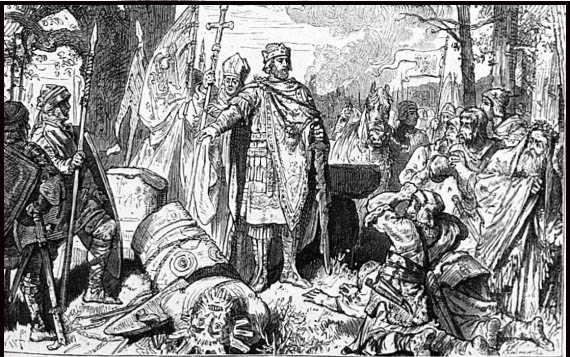
The Saxon Wars of Charlemagne, lasting from 772 to 804, was the first time in history that Christianity was used as an instrument of imperialist conquest. Charlemagne initiated formal hostilities by destroying pagan monuments in Saxony. In 782, Charlemagne promptly avenged a Frankish defeat at Saxon hands by massacring 4,500 Saxons in savage reprisal. The Saxon Capitulary of 785 ordered the death penalty for any Saxon caught resisting baptism or observing heathen practices.
Rulers forcibly converted pagans to Christianity for reasons of personal self-aggrandizement. Michael III, emperor at Constantinople, forced the Bulgarian Khan Boris to accept the eastern orthodox rite in 864, after he was defeated in battle. Forced Christianization allowed Michael to expand his sphere of influence in the Balkans. Bulgaria was then flooded with Byzantine clergy who, with the help of Boris’s army, began a nationwide campaign to demolish all pagan holy sites. The boyars accused the Khan of accepting laws that threatened the stability and autonomy of the state. In 866, they revolted against the khan’s forced Christianization of the country but were suppressed with great cruelty. In the final decade of the ninth century, Boris’s eldest son Vladimir, who became ruler of Bulgaria, tried to eliminate Christianity and restore paganism. In this endeavor, he was supported by the boyars. Vladimir ordered the killing of Christian priests and the destruction of churches. Boris was compelled to leave his monastic retreat and suppress the revolt. Vladimir was deposed, blinded and imprisoned in a dungeon, never to be heard from again.
By the 12th and 13th centuries, crusades were launched to convert the indigenous peoples of Scandinavia and the Baltic region to Christianity. There were crusades against the Wends, Finns, Livonians (Latvians and Estonians), Lithuanians and Prussians. St. Bernard of Clairvaux, a monastic reformer, called for the cultural and physical extermination of northern Europeans who resisted forced conversion to the Christian religion.
What has Christianity Done for Europe?
- Christianity is dangerous for the following reasons: the religion promotes the survival of the sick, the weak and the stupid at the expense of good racial hygiene. This drastically lowers population IQ and capacity for civilizational attainment, and;
- the cult relies on blind faith instead of rational persuasion, which has resulted in long periods of widespread chaos and bloodshed, especially during the Christianization of Europe. These dangers were even noticed by contemporary pagan writers, who immediately recognized the threat a triumphant Christianity would pose to the survival of Western culture.
Christianity never “civilized” or “domesticated” Europeans. On the contrary, Europeans were forced to endure a Neolithic existence when Christians were at the apogee of their power and influence. The church sent men of genius to monasteries or had them consecrated to the priesthood. This prevented them from passing on their genes, a significant dysgenic effect that lowered the collective European IQ. Only the pagan science and reason of classical antiquity could re-domesticate Europeans after 500 years of total intellectual darkness.
The church successfully defended Europe from invasion, argue some apologists, but nothing could be further from the truth. Charles Martel’s confiscation of church property to defend Europe from Moslem intruders was met with significant ecclesiastical opposition. If the church had succeeded in withholding the necessary funds, all Europe would have been reduced to a province of the Umayyad caliphate. Nevertheless, Martel was unable to pursue the Saracens across the Pyrenees and dislodge them from their Andalusian stronghold. The Moslems would continue their occupation of the Iberian Peninsula for 800 years, until their final expulsion by Ferdinand and Isabella in the late 15th century. Southwestern France and Italy were periodically raided and sometimes controlled by Moslem invaders. The emirate of Sicily endured for over two centuries. Even after Norman conquest, a significant Moslem presence remained on the island. The Moslems of Sicily were finally expelled by the middle of the 13th century. The crusades to retake the Holy Land from the Saracens (1095-1291), a series of large-scale military operations under the joint leadership of papacy and feudal aristocracy, failed to achieve its primary objective. In 1204, Christian crusaders sacked Constantinople in an orgy of rape, pillage and murder. The crusaders caused so much damage that the Byzantines were unable to resist their Ottoman conquerors in 1453.
Christianity provided no adequate defense of Europe. The church only did enough to maintain herself as a viable institution. In the process, the church weakened Europe, making her ripe for conquest by the Umayyad and Ottoman caliphates.
Apologists tentatively acknowledge that although Christianity hindered scientific and technological progress, it still made “contributions” to fields as diverse as architecture and philosophy. On closer examination, these “contributions” are neither “Christian” nor worthy of being considered “contributions.” The great churches of the Middle Ages are frequently trotted out, but these have their origin in Roman building methods. The dome, the arch and the vault, the typical features of the medieval Romanesque style of architecture are all borrowed from the imperial Roman architecture of pre-Christian times. The basic architectural plan of most medieval churches is the Roman basilica, a public building reserved for official purposes. Even the Gothic style that supplanted Romanesque still employed architectural features of Roman origin. The ribbed vaulting that was typical of Gothic architecture was originally used in Vespasian’s Roman colosseum and by Hadrian in the construction of his Tibertine villa.
While acknowledging Romanesque as an “accomplishment,” the Christian religionist will conveniently ignore the almost total disappearance of Roman building methods from western Europe for almost 300 years. This was a direct result of the church’s active suppression of Western scientific and technical knowledge. From the completion of Theodoric’s mausoleum in Ravenna to the consecration of Aachen in 805, nothing of monumental significance was built in western Europe. During the intervening period, Europeans, like their Neolithic ancestors, had returned to the use of perishable materials for use in building.
Apologists for Christianity will mention Aquinas and scholasticism as the highpoints of not only medieval, but European intellectual development, even though Aquinas set European scientific and technological progress back by hundreds of years. Scholasticism was an object of ridicule and mockery during the Renaissance. Religionists mention the Christian “contribution” of the university, oblivious to the many institutions of higher learning that existed and even flourished in the ancient world. The first universities taught scholasticism, so they were the frontline in the Christian war against the pagan values of intellectual curiosity, love of progress for its own sake and empirical rationality.
In the Christian religious mind, science and technology are of Christian origin because the men doing the discovering and inventing during the Scientific Revolution were nominal Christians, like Galileo and Newton. This argument is just as absurd as arguing that the Greek invention of logic, rhetoric and mathematics were the result of Greek pagan theological beliefs because Aristotle and other ancient scientists and philosophers were pagans. No, these men were “Christians” because public avowals of atheism were dangerous in an age where even the most innocuous theological speculation could smear reputations and destroy careers. It is a glowing tribute to the courage and honesty of these men that they were able to abandon Christianity’s reliance on blind faith, often in the face of public censure, and consciously re-embrace the pagan epistemic values that produced the “Greek miracle” 2000 years before the Scientific Revolution.
Christian religionists claim that the New Testament is a great contribution to Western civilization. As has been pointed out for generations, the work is notorious for its bad grammar and unrefined literary style. Much of it was composed by Jews who were not even fluent in koine Greek. Overall, the New Testament is an inferior production compared to the meanest writers of Attic prose. Even St. Jerome, the translator of the Vulgate, expressed contempt for the crude, unsophisticated literary style of the Bible. He preferred the elegant Latin of Cicero instead.
What has Christianity contributed to Europe? The answer is very little, if anything. No art, culture, architectural monuments, science or technology. Christianity was a massive waste of European intellectual and physical potential. Furthermore, Christianity almost destroyed Europe.
The church discarded over 99% of ancient literature, including works on science, mathematics, philosophy, engineering and architecture. This was the largest campaign of literary censorship and suppression in history, an act of cultural and physical genocide that nearly severed medieval Europe from the great achievements of classical antiquity. This was cultural genocide because the church nearly wiped out an entire civilization and culture; this was physical genocide because the church’s deliberate eradication of secular knowledge placed millions of lives in danger, unnecessarily subjecting them to the ravages of disease, war, famine and poverty. No other religion has caused as much suffering and as much damage to Europe as Christianity.
Selected Bibliography
Fletcher, R. (1997). The Conversion of Europe: From Paganism to Christianity 371-1386 AD. HarperCollins: London.
“Interview – Converting by the Sword.” Christian History. Issue #63, 1999.
Jones, A. H. M. (1964). The Later Roman Empire: A Social, Economic and Administrative Survey. 3 vols. Basil Blackwell: Oxford.
Nixey, C. (2017). The Darkening Age: The Christian Destruction of the Classical World. PanMacMillan: London.
Pollini, J. (2013). “The Archaeology of Destruction: Christians, Images of Antiquity, and Some Problems of Interpretation. The Archaeology of Violence: Interdisciplinary Approaches” Chaos e Kosmos XIV.
Sauer, E. 2003. The Archaeology of Religious Hatred in the Roman and Early Medieval World. Stroud: Tempus.
* * *
Source: Council of European Canadians



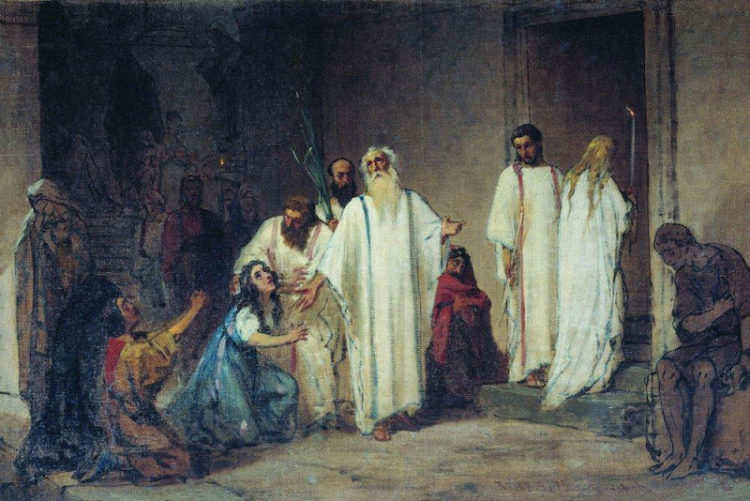
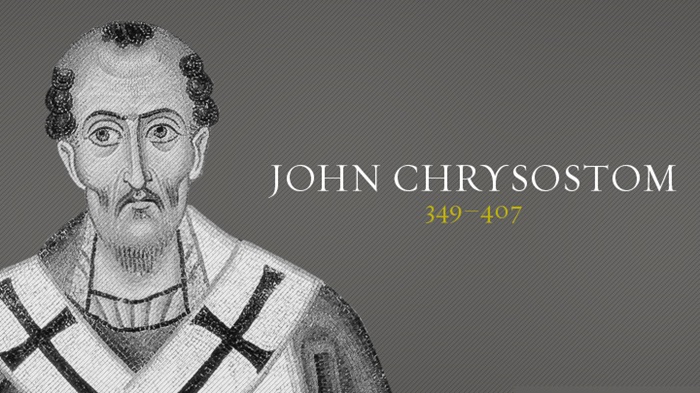
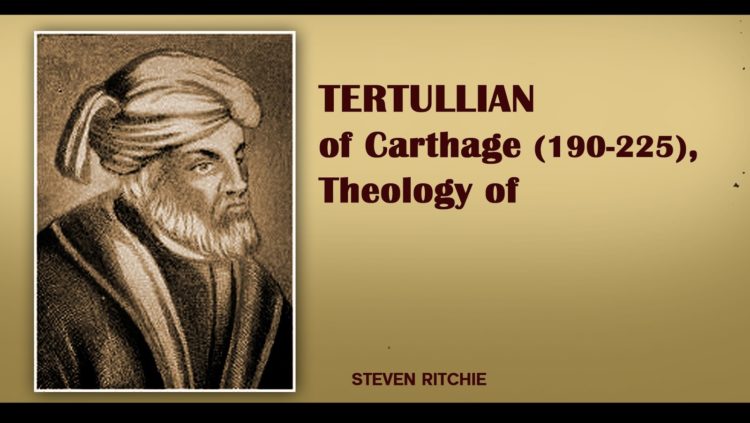

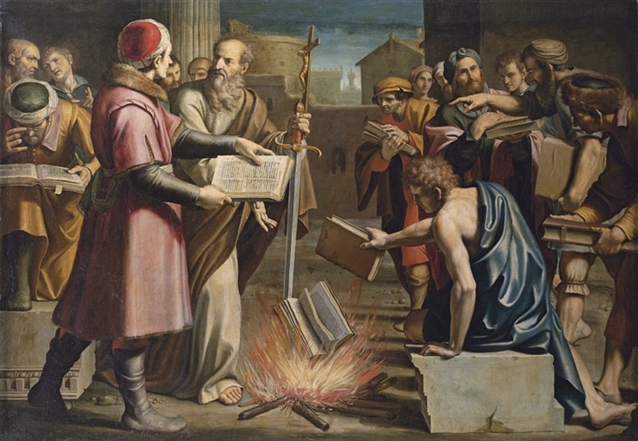
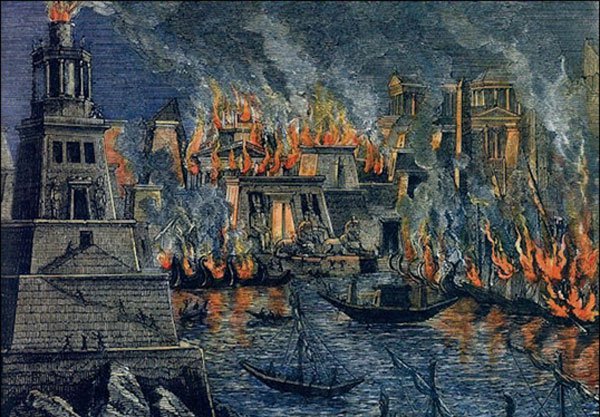
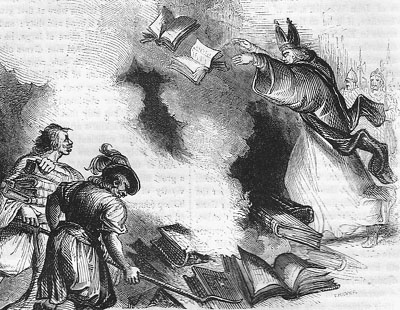
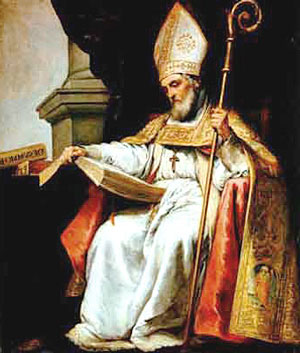
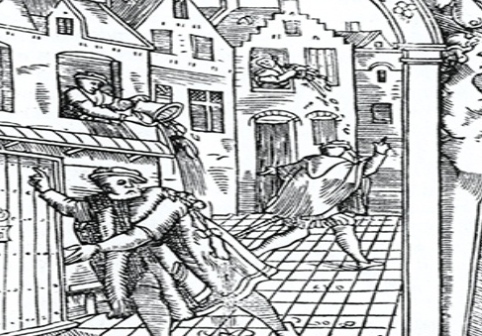
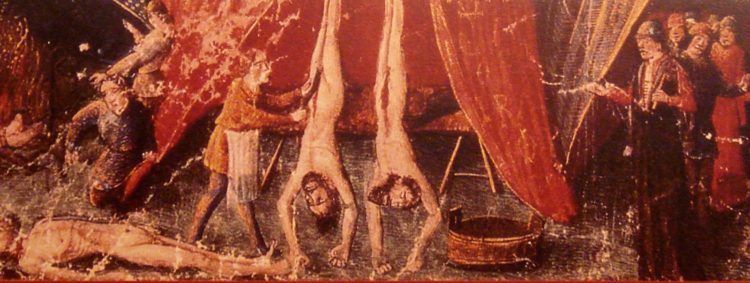
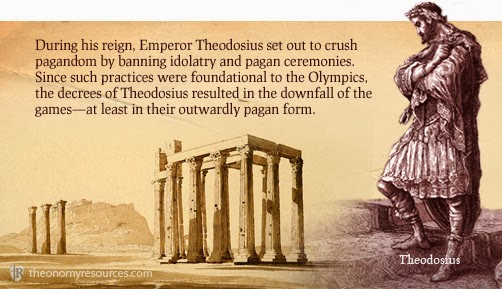

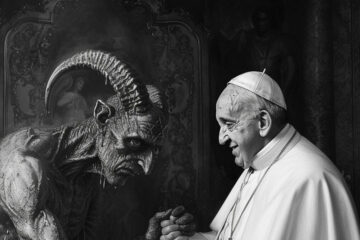

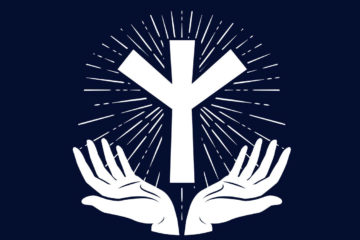
Is there an unbroken link between the ignorance demanded by the Christian church until the Renaissance, and that demanded by ultra-orthodox jewish education today and “for generations” past, with the latter providing secular knowledge only as needed to get public assistance (according to a former student)? Per https://www.usnews.com/news/best-states/new-york/articles/2018-07-22/questioning-real-world-learning-at-ultra-orthodox-schools
Sethmoto101, that line of questioning is very important as it imposes on us another question: Did the Jews impose Christianity upon our Aryan ancestors with the foreknowledge that the Judaic underpinnings would indeed cause so much ignorance and destruction to our people… or, as some thinkers have reasonably argued, have we Europeans merely fallen victim to the cultural equivalent of the disease typhus, an unintended (from Jewish rats’ perspective) but logical outcome of poor racial hygiene and ignorance on our own part? My personal view is that it has been a little of both. Since Jews aren’t actually rodents, but humans with the ability to think and reason like anyone else, I believe that, as was the case when they began to take over mediums of communication and banking in… Read more »
By 450 AD, the era the article focuses on, Christianity’s leaders were almost all white Europeans or other non-jewish mediterraneans, and its split from judaism was clear as jews were now blamed for the Crucifixion – due to John Chrysostom! See https://en.wikipedia.org/wiki/Christianity_in_the_5th_century#Post-Nicene_Fathers . Christianity arose during Rome’s height. When Roman pagans made it a state religion, its edicts left/kept the Western empire defenseless on hygienic, military, political, and economic grounds. Jews had profitted well from commodity trade and loans, gossip and consumerism; the collapse of Rome eliminated those, so Jews ended up trading in nordic pagan slaves, with complicity from pagan kings, but that was banned by the Church (with reversals and qualifications later), noted here: https://en.wikipedia.org/wiki/Slavery_in_medieval_Europe#Jewish_merchants and here: https://en.wikipedia.org/wiki/Christian_views_on_slavery#Patristic_era. As filth replaced hygiene and superstition replaced science, due to… Read more »
What a magnificent essay! I must confess that I’m only halfway done reading…but I wanted to comment on something: I find it very frustrating that when folks get “red-pilled about the JQ”, when they get a glimpse of the merest tip of the gargantuan iceberg, especially Westerners, they immediately seek refuge in the very thing that has aided the Jews in nearly conquering our people, Christianity. These “red-pilled” neophytes begin quoting scriptures about “the synagogue of Satan”, “serpent seed”, about how Jesus chased the Jews out of the temple with a whip and everything else… And these poor, ignorant people haven’t the faintest clue as to just how deep and massive the Jewish iceberg truly is. For example, they don’t fully grasp the psychological tactic of controlled-opposition… and how the… Read more »
The completeness and enormous time-frame of the collapse of learning, commerce, science, basic hygene and fitness, classical art, and population reveal a potential extinction event due to the concurrent rise of Islam, and it all irrevocably coincided with the tightening grip and expansion of the Christian Church that in its control of Europeans’ daily lives (really slow deaths) from cradle to coffin, portends the totalitarian rise of Communism meant to crush the rise of an aristocratic republican government, the long-dormant Aryan system, among Europe’s working class. Jews were well represented at the roots of both Communism and Christianity, to put it kindly. Sadly, the Christian Church had the wherewithal to prevent much of the peasantry’s suffering at any time, through its influence and networking that could’ve revived trade, a non-usurious… Read more »
Good response to a very good article, JimB.
I think it all goes back to the principles of magic—misdirection, false appearances, duplicity, etc. Now magic is a great and wonderful art-form, but it is being done in real life to a people whose brains usually do not function that way—-Europeans (which is unfortunate).
For example, when Oriental types fought Europeans, they would employ the same tactic, from Mongols to American Indians. They would send out a small force which would retreat, seemingly in defeat. The Europeans, being straight up-and-down thinkers, would always pursue them into a hidden ambush and get slaughtered.
We have got to pay more attention to those people who can help us think in more flexible ways—artists, magicians, philosophers, writers, etc.
EXCELLENT ARTICLE.
For me, the most important reason was that Jews-us never existed. Even the name is fake. A Roman invention (See Caesar’s Messiah).
And the evil pope, kissing the feet of alien invaders.
There are over 100 books proving that Jews-us is myth.
Books that prove Christ Never Existed, available online:
The Christ, by Remsberg
Pagan Origins of the Christ Myth, by Jackson.
Forgery of the Old Testament, by Priest Joseph McCabe.
Forgery in Christianity—Wheless.
http://www.positiveatheism.org/hist/rmsbrg00.htm
jesusneverexisted.com
The Age of Reason—Thomas Paine.
Mistakes of Moses—Ingersoll.
Caesar’s Messiah–Joseph Atwill.
Time to get out of Christianity, a Middle Eastern Cult, based on worshiping a mythical Jew. The ancient pre-Christian religions of our ancestors are a better option.
This is one of the most powerful articles posted on NV. So, a parable is in order: In the early Dark Ages, the jews were not bound by the cross. They could’ve taken possession of the pagan and classical works of Europe for a pittance, such as by providing monks with fresh writing surfaces made in the East, with Christian leaders praising the religiosity of the arrangement. The jews were extant record keepers, as seen by their Talmud and notes to it. What if they had chosen to maintain and copy the documents of the classical world that remained after the fall of Rome, with success that matched their less noble pursuits in the slave trades and money lending? Europe today would be far more advanced technologically, likely long colonized… Read more »
Speaking of one people helping another: As I understand it, it was actually Muslim scholars who had saved the works of Aristotle and other Greeks, and then generously reintroduced them into Europe.
Is that mentioned in Bardamu’s article? It seems such Muslim copies would be popular works or basic math formuals needed for rudimentary construction (though not as rudimentary as in Dark Age Europe), with their modern equivalents being non-fictions by Carl Sagan or Neil Degrasse Tyson, not technical works by Stephen Hawking.
I don’t know how many of you guys are familiar with Fomenko’s alternate history. For those who are not familiar with his work I will try to explain briefly. He hypothesizes that according to astrological charts(computer modeling) and using astrological signs given in the writings of the alleged time he found that 1000 years of history has been injected into our official time line. While there is no concrete proof it does raise many questions about the accuracy of the history we have been taught and the works that are attributed to those times. Every book we have is a copy of a copy. All of them copied by Gregorian monks. Point being we really do not know what has happened in the past. As Napoleon said “History is a… Read more »
Archeological dating methods such as radio carbon using the half-life of carbon 14 in preserved formally-living reatures, would’ve been used to confirm the 1,000 year insertion.
Radio carbon dating has never been nor will it ever be an absolute when it comes to dating. Nor do the scientist have any obligation to be honest about there results. There is however physical evidence of an empire that has been erased from history. It is not a myth or a legend. And it certainly wasn’t thousands of years ago. There is a lot more going on here then we realize.
The unchecked plagues in Europe caused by the superstition fostered by Christianity may be the seeds of modern plagues: autoimmune diseases such as rheumatoid arthritis, Crohns Disease etc. This is because those with very powerful immune systems were the only ones who could survive the era of filth and backwardness that discarding hippocratic traditions, eugenics and basic hygiene brought forth. The flip side of having such natural immunity may be the danger that it will turn against its host. I have no proof of this, but I don’t believe there were any classical accounts of such diseases as Crohns. As ignorant as I am, I found these chillers: “The researchers think genetic adaptations caused by exposure to diseases earlier in history could have caused autoimmune diseases in modern populations.”, from… Read more »